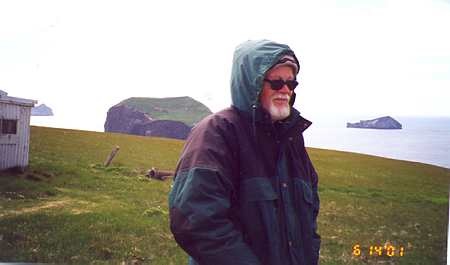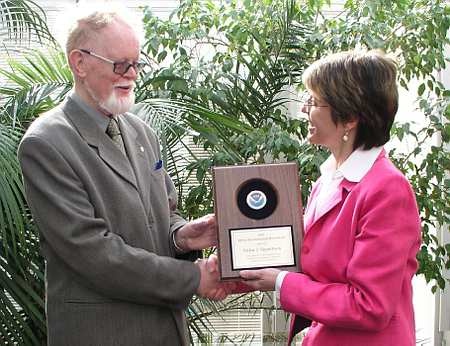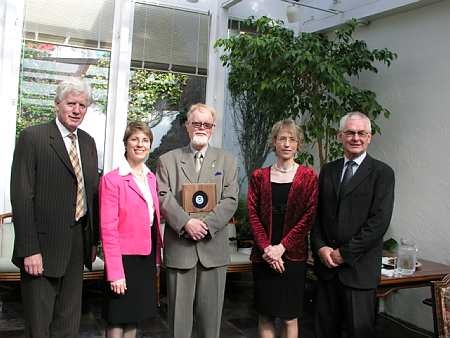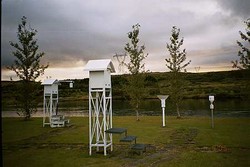Pollution
Holuhraun - lava field
Various information regarding the eruption in Holuhraun (off Bárðarbunga), from August 2014 through February 2015, was provided on the web:
- Gas dispersion forecast. Forecasts by meteorologist on duty are no longer necessary.
- Gas dispersion model. Gas dispersion model, automatic.
- Observations from the public. A web form was presented to the public to register if the scent of sulphur was detected in their vicinity. All observations are now available on the map.
- Measuring sites. On the EAI is a map of the location of the measuring sites (blue dots only).
- Air quality. Various information regarding air quality can be found on the EAI webpage, including a table of the appropriate reaction to increasing concentration of SO2.
- Good advice. Directorate of Health; also gives appropriate reaction to raised values of SO2.
Írafoss - an inland background station
Írafoss is situated at a hydropower station in Grímsnes in south Iceland surrounded by pasture and heath with some farmland and a river close to the site and a lake nearby. Elevation is 65 m above sea level, distance from the sea is 26 km and distance to towns of about 1000 inhabitants is about 15 km. This is an ideal inland background station at 64oN 21oW.
Since 1980, daily sampling has been done at Írafoss, monitoring sulphur concentrations and related substances. In fact, daily sampling was done at Rjúpnahæð, closer to Reykjavík, eight years before that. As elsewhere in Europe sulphur concentration is lower now than when measurements began. Average value of sulphur is about 0.5 mg/l in precipitation, about 0.1 μg/m3 in aerosol and about 0.07 μg/m3 in air.
Stórhöfði - a seashore background station
Stórhöfði is at the south end of island Heimaey which is the largest of the Westman islands, Vestmannaeyjar, 12 km off the south coast of Iceland. It is surrounded by sea to the east, south and west. The elevation above sea level is 118 m. Distance from the fishing town on the island is 4.5 km, distance to the nearest village on shore is 40 km and distance to the nearest town on shore is 70 km. That town has less than 5000 inhabitants. This is an ideal seashore background station at 63°N, 20°W.
Persistent organic pollutants in precipitation and air have been monitored at Stórhöfði since 1995. Heavy metals in precipitation have been monitored at Stórhöfði since 2001 and in aerosol since 1995. The results are processed at the Icelandic Meteorological Office and sent to a European data base at the Norwegian Institute for Air Research, NILU.
Stórhöfði - an internationally acknowledged station
Various scientists made use of the ideal location and good staff of Stórhöfði for their research for decades. University of Miami monitors airborne sulphur of biological origin, stemming from seasonal algae off the coast, as well as dust storms off the glacial outwash plains. State University of New York analyses compressed air samples from Stórhöfði, investigating stability of air composition. Environment Canada does passive sampling of persistent organic pollutants. Surface ozone is monitored by the National Oceanic and Atmospheric Administration, NOAA, of Boulder, Colorado.
Greenhouse gases have been monitored at Stórhöfði since 1991 by NOAA where the results are interpreted with similar data from all over the world. Continuous data plots of various greenhouse gases at Stórhöfði are available from NOAA (choose Iceland from the map and submit your request). Also, NOAA has referred to the global history of CO2 in a video presented in 2010.
Óskar - a quiet giant
Óskar Jakob Sigurðsson is born in 1937 in Vestmannaeyjar, off the south coast of Iceland. His father was lighthouse keeper and weather observer at Stórhöfði, as Óskar's grandfather before that. Stórhöfði lighthouse was built in 1906. At first it burnt oil, in 1943 a gasoline engine supplied some electricity, in 1957 a diesel engine supplied enough electricity but needed great attendance and finally in 1979 the lighthouse received electricity from the mains.

Weather observations began at Stórhöfði in 1921 and since 1940 at night as well. Nine years of age Óskar began keeping a diary on weather and assisting his father. In 1952 Óskar began regular weather observations, in 1953 he began tagging seabirds and in 1966 when his father died Óskar took over both the duties of weather observations and attending the lighthouse. Weather observations were done every 3 hours, every day of the year. Óskar did not missed a single one while on duty except when a volcanic eruption occurred in the village in 1973: Óskar attended a crucial mass in the island's church. In 1991 Óskar began sampling air for NOAA and did so weekly until his retirement in 2014. Various other American, Canadian and Norwegian scientists and institutions have also benefitted from his meticulous work in monitoring the Earth's atmosphere at this wild location in the North Atlantic.
Óskar has received various local awards (1986, 1989, 1994) in Vestmannaeyjar. In 1997 he received the Order of the Falcon from the President of Iceland and same year it was recorded in the Guinness World Records that no man had tagged more birds than Óskar. All in all, this amounted to over 40 species and 91,695 birds. In 2005 the weather station received a declaration of recognition from WMO which is given only to those stations which fulfill highest standard of reporting.

Additionally, Óskar received NOAA's annual Hero Award in April 2007. From a staff of 12500 only ten were chosen this year and only two nominees were allocated to the greenhouse gases lab who selected Óskar.

Óskar's son, Pálmi Freyr, assisted him during the last decade or so but 1st November 2014 Óskar began his late retirement at the age of 77 and moved to the mainland. Stórhöfði was the last manned lighthouse in Iceland and the only place where such varied and careful scientific research took place.




